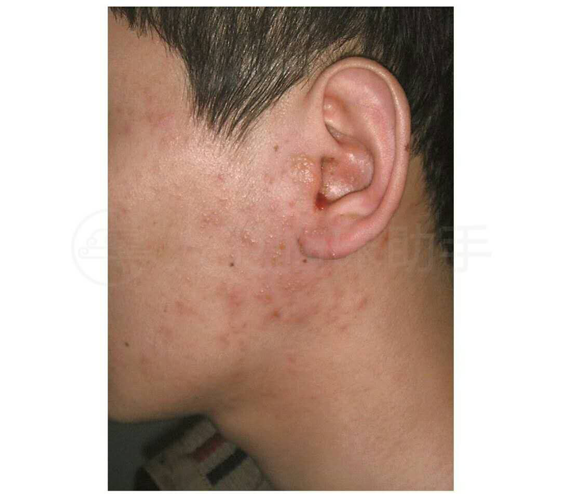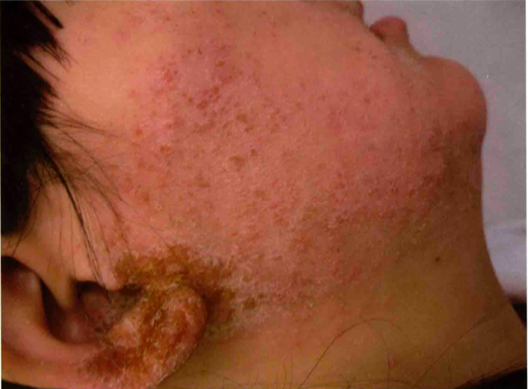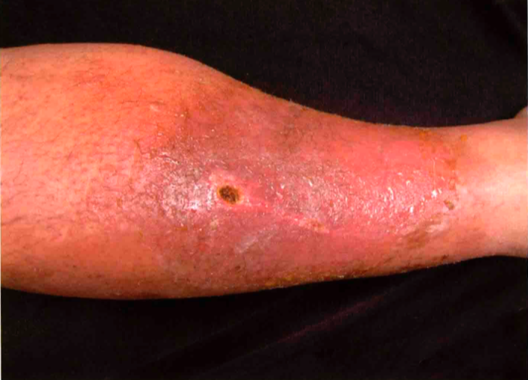Infectious eczematoid dermatitis
OVERVIEW
What is infectious eczematoid dermatitis?
Infectious eczematoid dermatitis is a skin condition caused by chronic bacterial infections (commonly staphylococcal infections), where secretions from the infected site irritate nearby skin, leading to eczema-like changes. It is now referred to as infectious eczema.
It can occur in both children and adults. Most patients can alleviate symptoms by actively treating the primary infection, reducing secretions, and applying topical medications to the affected area. The prognosis is generally good.
Is infectious eczematoid dermatitis common?
Infectious eczematoid dermatitis is relatively common in surgical patients, such as those with ulcers, pustules, fistulas, chronic otitis media, burns, open fractures, pressure sores, etc.
Is infectious eczematoid dermatitis contagious?
No, it is not contagious. Infectious eczematoid dermatitis is an infectious dermatitis surrounding the lesion, related to secretions, bacterial toxins, and the patient's own sensitivity. It does not spread to others.
SYMPTOMS
What are the common manifestations of infectious eczematoid dermatitis?
Initially, it may present as a blister, abscess, boil, crusted or oozing papule, macule, an open wound caused by trauma, pressure sore, fistula, or an infected lesion in areas like the ears, nose, eyes, or vagina. It then gradually or rapidly spreads to surrounding skin, forming eczema-like rashes characterized by redness, dense small papules, blisters, pustules, crusting, and scaling.
The rash has irregular borders, and widespread dermatitis may occur elsewhere on the body due to auto-sensitivity.
As symptoms subside, the affected area becomes dry, crusted, and scaly.
In severe cases, symptoms may include redness, swelling, oozing, blisters, pustules, erosion, and swollen lymph nodes near the affected area. In extreme cases, the lesion may spread to an entire limb or even the whole body.
Many patients experience varying degrees of itching. Some may exhibit linear or streaky rashes after scratching.



Where does infectious eczematoid dermatitis commonly occur?
Infectious eczematoid dermatitis can occur on any part of the body, with common sites including the ears, limbs, and sacral pressure sores. The key factor is the presence of infection and excessive secretions from the primary lesion, which irritate the surrounding skin and lead to rashes.
How does infectious eczematoid dermatitis develop?
Initially, infectious eczematoid dermatitis appears as a small eczema-like rash around the primary infection site. It then gradually or rapidly expands into patches or even large areas of rash, potentially covering an entire limb or the whole body in severe cases.
If the primary lesion is not treated actively and secretions persist or recur, the dermatitis may also persist or recur.
What complications can infectious eczematoid dermatitis cause?
Without prompt treatment, infectious eczematoid dermatitis may lead to severe infections.
CAUSES
What is the cause of infectious eczematoid dermatitis?
The onset of infectious eczematoid dermatitis is related to the stimulation by secretions from primary bacterial infection foci and their bacterial toxins, as well as auto-sensitivity.
Who is commonly affected by infectious eczematoid dermatitis?
Infectious eczematoid dermatitis often occurs in individuals with chronic infection foci or excessive secretions.
Is infectious eczematoid dermatitis contagious?
It is not contagious to others but can spread within the same individual ("auto-infection"), meaning areas exposed to secretions from the primary infection site may develop infectious eczematoid dermatitis. Therefore, actively treating the infection focus and cleaning secretions can help alleviate symptoms.
DIAGNOSIS
How is infectious eczematoid dermatitis diagnosed?
When diagnosing infectious eczematoid dermatitis, doctors primarily consider the following: the primary infection site and surrounding eczematous rashes (skin redness, dense papules, blisters, pustules, crusting, and scaling).
What tests are needed for infectious eczematoid dermatitis?
Infectious eczematoid dermatitis is generally diagnosed based on symptoms and does not require further testing.
- If the infection site is severe, secretions from the affected area may be collected for culture and sensitivity testing to identify the specific bacteria and guide antibiotic treatment.
- For more severe infections, blood tests or other related examinations may be needed, or the doctor may assess whether referral to internal medicine is necessary to evaluate potential chronic conditions (e.g., diabetes).
- If the rash is caused by infections in areas like the ears, nose, eyes, or vagina, specialized tests such as otoscopy, localized ultrasound, X-rays, or CT scans may be required under the guidance of a specialist.
What precautions should be taken for secretion culture testing in infectious eczematoid dermatitis?
- For open abscesses, clean the surface with sterile saline, then use a sterile swab moistened with saline to collect pus and deep secretions, placing them in a sterile tube for testing.
- For closed abscesses, disinfect the skin first, then aspirate pus with a syringe or collect samples with a swab during incision and drainage.
- For burn wounds with exudate, firmly swab the base or edges of the lesion.
- For pustules or blisters, disinfect the area, puncture with a needle, and use a swab to collect fluid and base samples.
Which diseases can infectious eczematoid dermatitis be confused with? How to differentiate them?
Infectious eczematoid dermatitis should be distinguished from contact dermatitis, eczema, impetigo, and seborrheic dermatitis. The key distinguishing feature is the absence of a primary infection site in these conditions. Additionally, it should be differentiated from allergic reactions to topical medications used on the primary infection site—discontinuing the suspected allergen usually leads to symptom improvement or resolution.
TREATMENT
Which department should I visit for infectious eczematoid dermatitis?
Dermatology or surgery. If the rash is caused by infected lesions in areas such as the ears, nose, eyes, or vagina, you may also need to visit the relevant specialized department.
Can infectious eczematoid dermatitis heal on its own?
If the primary infected lesion continues to secrete fluids that irritate the surrounding skin, infectious eczematoid dermatitis may persist for a long time.
Of course, some milder primary infections may resolve on their own due to the body's immune response. Once the infection clears, the secondary infectious eczematoid dermatitis usually improves as well.
How is infectious eczematoid dermatitis treated?
The most important step is to address the root cause by treating the primary infection, such as administering antibiotics or debridement and dressing changes.
Additionally, antihistamines may be prescribed, along with topical treatments for the dermatitis (e.g., medicated washes or wet compresses for oozing lesions, and topical corticosteroids or antibiotics for dry or minimally oozing lesions).
Does infectious eczematoid dermatitis require hospitalization?
This mainly depends on the severity of the primary infection. Infectious eczematoid dermatitis itself usually does not require hospitalization.
What are the common side effects of medications for infectious eczematoid dermatitis?
For treating the primary infection, oral or intravenous antibiotics are typically prescribed, with common side effects including allergic reactions and diarrhea.
As for oral antihistamines used for the dermatitis, reported side effects may include dizziness, drowsiness, and dry mouth.
Topical treatments such as washes, wet compresses, pastes, or ointments may cause mild local irritation, which usually subsides after discontinuation.
Can infectious eczematoid dermatitis be cured completely?
This largely depends on whether the primary infection is treated promptly and effectively. If the infection is controlled and secretions are reduced or eliminated, along with appropriate management of the dermatitis, it can generally be cured.
DIET & LIFESTYLE
What should patients with infectious eczematoid dermatitis pay attention to in their diet?
- Avoid foods that have previously caused allergies, unfamiliar foods, and spicy or irritating foods.
- Maintain a balanced and nutritious diet with a reasonable mix of meat and vegetables, which is beneficial for the recovery of the primary infection site.
What should patients with infectious eczematoid dermatitis pay attention to in daily life?
Avoid alcohol, tobacco, coffee, and strong tea, and prevent scalding with hot water or scratching the affected area, as these may worsen symptoms.
Does infectious eczematoid dermatitis require follow-up visits? How?
If the condition is in an acute exudative state with severe rashes, daily follow-up visits for dressing changes and wet compresses may be necessary. When exudation decreases, ointments are usually prescribed for home application, eliminating the need for frequent follow-ups.
Of course, regular follow-ups and wound care for the primary infection site are more important.
Can patients with infectious eczematoid dermatitis engage in strenuous exercise?
It mainly depends on the severity of the primary infection, whether it affects movement, or overall health. Generally, uncomplicated infectious eczematoid dermatitis does not interfere.
How should family members care for a patient with infectious eczematoid dermatitis?
Encourage the patient to follow medical advice regarding medication and follow-ups, keep the affected area dry and clean, and ensure a nutritious diet and a positive mood.
For those suffering from severe itching, in addition to prescribed medication, offer comfort and encouragement or distract them to alleviate symptoms and prevent scratching.
PREVENTION
Can infectious eczematoid dermatitis be prevented? How to prevent it?
If there is a wound, seek medical treatment promptly to avoid infection. If there is an infected lesion, seek medical treatment promptly to prevent worsening. This can reduce the probability of developing infectious eczematoid dermatitis.
How to prevent recurrence of infectious eczematoid dermatitis?
Follow medical advice and actively treat infected lesions until complete recovery to reduce recurrent episodes of infectious eczematoid dermatitis.
How can patients with infectious eczematoid dermatitis prevent complications?
Actively controlling infection is the most important measure.